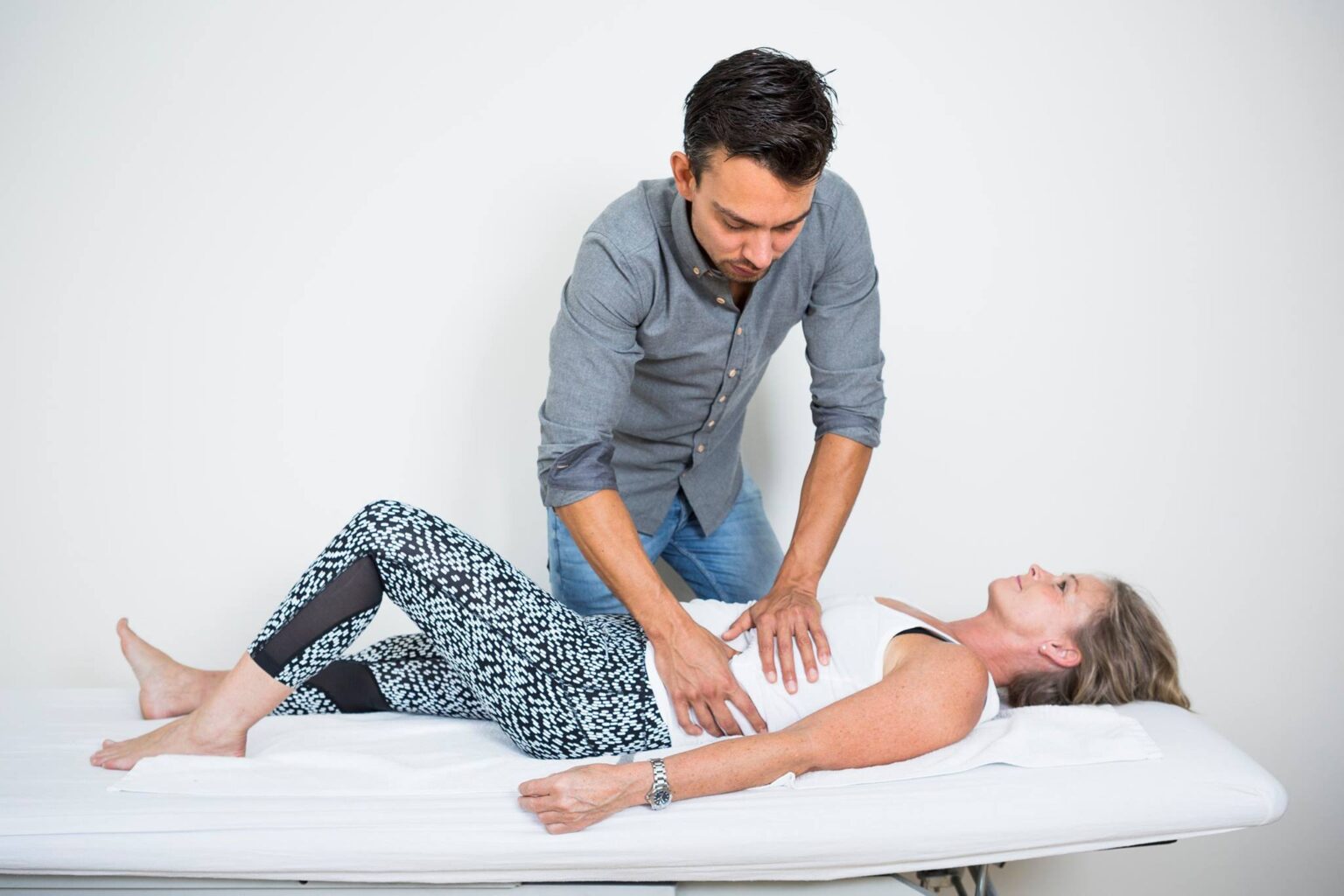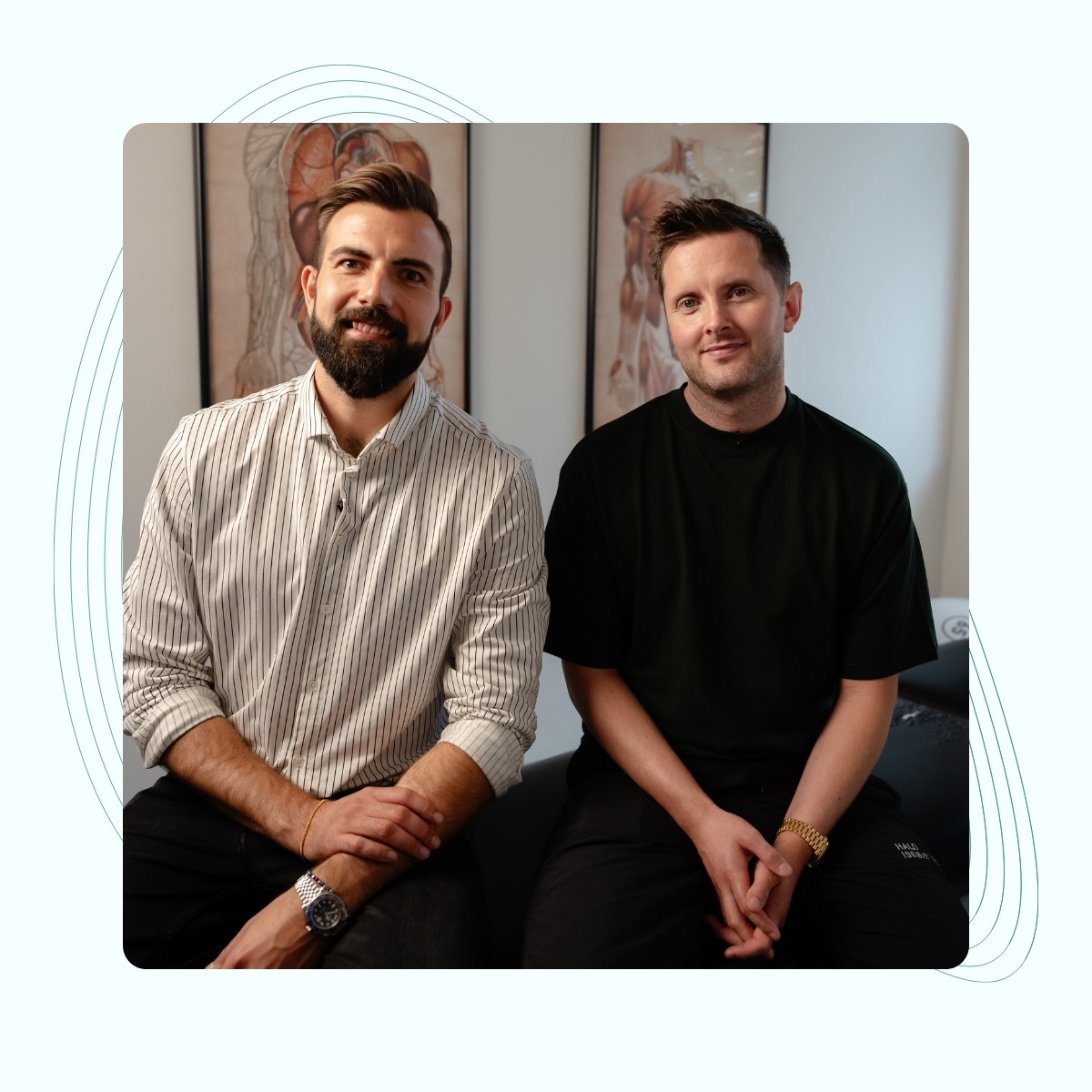We treat
Pelvic girdle pain
Learn more about pelvic girdle pain on this subpage.
What is pelvic girdle pain?
Pelvic loosening is what happens during pregnancy, where the hormone relaxin together with progesterone loosens the ligaments in the body. This especially affects the pelvis, as the joint is primarily held by ligaments and not muscles, which hormones have a big influence on. The loosening of the pelvis is completely normal and must occur to prepare the pelvis for birth, without the loosening it will not make the birth possible.
The diagnosis of pelvic loosening is used if you have pain during pregnancy, but there is no clear evidence that those who have pain during pregnancy are those who have large amounts of loosening hormones in their bodies, so the loosening itself is a normal physiological process during pregnancy. Pain during pregnancy is more multifactorial.
Jump to section [Vis]
Pelvic floor dysfunction and pregnancy
When women become pregnant, many different mechanisms are activated in the body related to the hormonal system. The body must be prepared so that the fertilized egg can be absorbed by the body, so that the fetus can develop and be optimally protected in the body and later so that the body is prepared for birth. The first and last 3 months play a particularly important role in this.
At the end of pregnancy, the hormone relaxin is released to soften the cervix and loosen the pelvic joints. The purpose is to physically prepare the woman for the actual birth.
Dysfunctions in the hormonal system can both cause hormone production to decrease, making childbirth difficult and the baby possibly having to be born by cesarean section, but also cause too many hormones to be produced, making the pelvic joints and other joints in the body too flexible (hypermobile). Other joints that are often affected are the back and lower back, knees and feet.

Reasons for pelvic loosening
Causes of this can be stress and psychological problems, dysfunctions in hormone-producing glands, dysfunction of the autonomic nervous system, dysfunction in metabolism and excretion, neck problems and back pain.
Pelvic pain and pregnancy
Pelvic pain can also occur due to dysfunction in the hormonal system, as relaxin softens all joints in the body. Tension in the thigh muscles, gluteal muscles and groin muscles can also cause pelvic pain. Pelvic discomfort can also occur secondary to problems in the back and lower back.
Pelvic pain in pregnant women can manifest itself in various forms. The most common are pain across the lower back, pain radiating down the buttocks and thighs, pain in the groin and pubic bone. Activities such as running, climbing stairs and walking can often trigger pain and discomfort in the pelvis.
SI joint pain (sacroiliac pain)
The sacroiliac joints are formed between the sacrum and the ilium, and there is a small amount of movement, probably about 5 degrees of rotation in the joints. There are no muscles running over the joints, so they are held in place by many strong ligaments. When you have joint pain, it is the ligaments that are causing the pain.
This can be caused by either too much movement, or by stiffness in the joint, where the ligaments are held in an extreme position for a long time. It is similar to a sprain, where small injuries occur in the ligaments, which therefore cause inflammation, which comes to heal the injury. If the body has the right conditions, it heals itself again.
Symphysis pain – Pubic bone pain – Symphysis release
The symphysis (pubic bone) is formed where the two pelvic bones meet, forming a false joint. There is cartilage between the two bones and the joint is held by ligaments. You may have pain in the ligaments that hold the joint. This can be due to increased looseness, or if the joint is held in an extreme position, where there is a lot of stretch on the ligaments.
Pain in the area can also stem from ligament pain from the uterus that runs over the symphysis (round ligament). When the uterus grows, there is a great stretch on these ligaments, which can give pregnant women ligament pain.
Coccyx pain (os coccyx, sacrococcygeal)
Many people experience tailbone pain during their lives after a fall, in most cases it goes away. There is a mucous sac on the tailbone, it can be irritated by pressure, in addition, the pelvic floor and 2 ligaments from the pelvis attach to it, which can affect the mobility of the tailbone.
Pain that continues for 2 weeks after a fall and 6 weeks after a broken tailbone (fracture) may be because the tailbone does not move optimally after the trauma.
For example, when you sit back in a chair, the tailbone must be able to move forward under the buttocks, so that you do not sit on it. When you sit on the left buttock, the tailbone will move to the right, so that you do not sit on it again. If it has impaired function after a trauma and cannot move, you will automatically sit more directly on the tailbone and the pressure on the sacrum increases, so that inflammation is created, or the inflammation from the trauma cannot calm down.
As osteopaths, we treat the function and movement of the tailbone.

Pelvic pain during pregnancy
Many people experience pain during pregnancy, and because there are so many major changes in the body, it is quite normal to have mild discomfort, but many also experience more severe discomfort where they have difficulty maintaining a normal everyday life.
- 50% experience mild back discomfort
- 15-20% experience severe pain where normal everyday activities hurt
- 5% experience what we call pelvic dislocation – which refers to pain in both the symphysis (pubic bone) and the SI joints (pelvic joints)
Source: Sundhedsstyrelsen
Tailbone pain after childbirth
During childbirth, the baby must pass between the symphysis and the coccyx. During a difficult birth, a large baby or if you have had reduced movement around the coccyx, this can put pressure on the coccyx from the inside. It can be incredibly painful and, in the worst case, cause a broken coccyx. This pain can continue if the mobility of the coccyx is not restored after the trauma. Especially during a supine birth, the chance of getting pressure on the coccyx is greater, as when lying on the sacrum, the sacrum cannot move backwards and therefore the coccyx is forced to move more.

Causes of pelvic pain
Problems with mobility of the hip, back and ankle are often a contributor to pelvic pain. The function of the pelvis is to transmit the load from the leg to the rest of the body.
Therefore, the pelvis is required to have great mobility, strength and stability. Tightness and lack of mobility in the above areas is therefore essential to prevent the pelvis from being overloaded.
Other causes may be poor core strength of the muscle corset, scar tissue in the pelvis and problems with internal organs in the pelvis.
Osteopathy and pelvic girdle pain
Osteonordic has experts who are specialized in finding and treating the causes of pelvic loosening and pelvic pain. We examine all systems in the body, which together should help optimize the healing of pelvic loosening and pelvic pain.
Good advice for pelvic girdle pain – What can you do yourself?
Stay active with the things you can, make sure you get moving so that you don’t become inactive, as this often worsens the risk of the genes becoming active. At the same time, adjust your everyday life so that you don’t do the things that are most provocative, be good to yourself and spend time on the things you can do that make you happy and relax you, this helps your own body’s painkillers called endorphins.
Good advice:
- Good posture
- Pretension in the pelvic floor and deep abdominal muscles during lifting and movements
- Avoid heavy lifting and housework
- Short stride length
- Changing sitting positions
- Take the stairs one step at a time
- Pelvic floor and muscle corset training
- Water gymnastics with a focus on movement and relief
- Breathing exercises
- Lymphatic exercises
Causes of pregnancy pain
During pregnancy, major changes occur in the body.
- The posture changes to compensate for the increased weight and size of the stomach in front, this causes the sway in the lower back to increase and the roundness in the thoracic spine to become greater, i.e. the curves of the back increase.
- The weight changes and the body has to carry around extra kilos.
- The uterus expands, which increases the stretch on the ligaments and puts more pressure on the pelvic floor.
- Hormonal changes occur that cause the pelvic ligaments to loosen.
This places great demands on the body, it must be able to compensate and adapt to these changes. Therefore, there must be good strength and function when you enter pregnancy.
The biggest risk factors for pelvic pain are when the body is already affected and therefore unable to adapt optimally to all the changes that occur during pregnancy. So there may be some problems already, just not enough to cause pain and discomfort, but then pregnancy comes along and many changes in the body on top of this and the body can no longer compensate.

Osteopathy for pregnancy pain
As osteopaths, we are one of the only manual therapists who have many hours of training on what happens during pregnancy and in the female body in general. So we have a great understanding of pregnancy discomforts, where other professional groups must at least have taken extra courses to know enough about treating pregnant women.
As osteopaths, we try to increase the body’s function so that it can heal itself and function better.
We therefore conduct a thorough examination of the body and treat all structures that have restrictions so that the body can better adapt to the changes that occur during pregnancy.
In addition, all our osteopaths are trained physiotherapists and are therefore also experts in exercise, so we will typically give light home exercises to maintain strength and stability in and around the pelvic muscles. This will be followed by a lot of advice and guidance for you and your partner to help you have a good experience during your pregnancy and birth.
Birth preparation and osteopathy
Birth is a huge miracle, and it requires a tremendous effort from the body, and many structures must simultaneously give in to an incredible amount of effort in order for a birth to be possible.
When we treat pregnant women, we focus on preparing the pelvis and tissue for birth.
The pelvic floor must be able to expand 3 times its normal length, so restrictions and tension here can cause major problems.
- The tailbone and sacrum must be able to move backwards to make room for the baby’s head. If they cannot, and depending on the baby’s size and position in the pelvis, the tailbone can be put under a lot of pressure, which can be incredibly painful and, in the worst case, break (fracture). Therefore, if you have had previous falls (trauma) on the tailbone, it can affect the birth.
- The perineum must be mobile. If you have a lot of sedentary work or have had pain from your last birth, the perineum may be stiff and not expand enough during birth. In this case, we often guide the pregnant woman in self-massage.
- The ligaments, muscles and connective tissue around the uterus must be flexible to allow the baby to lie in the optimal position in the pelvis. For example, if there is tightness and stiffness in the entire left side of the hip flexors and diaphragm as well as the ligaments from the uterus, the baby may not be able to easily get into the most optimal birth position with the back of the head towards the left pelvis.
- The joints in the back and pelvis must be able to expand during birth for the baby to pass through.
So even if you experience pregnancy pain, this will also be addressed to give you and your child the best experience and start together.

Good advice for birth preparation – Get ready for birth
- Pregnancy yoga, swimming, especially backstroke, and walking are good before birth to keep the pelvis and all its muscles and connective tissue mobile.
- Make sure you get healthy, nutritious food and not empty calories. You need to have plenty of nutritious food in the fridge. When the birth approaches, it is important that you eat plenty of good and nutritious food, so that you have the nutrition and strength for the birth. Often, especially the first time giving birth, it can drag on and you rarely get enough nutrition beforehand, so you become exhausted more quickly.
- Increase your oxytocin, the body’s own feel-good hormone, leading up to birth. Anything that helps stimulate oxytocin: Put on warm clothes, lie down with blankets, get kisses, hugs and massages from your partner, go for a walk, get cuddled, talk to all the people you feel love for and generally focus on being in a safe and cozy environment.
Pain after pregnancy and childbirth
The changes that occur in the body after pregnancy do not always find their balance on their own after pregnancy, and if you have had pain and discomfort and have therefore been very inactive, you may have lost stability and strength, which makes you more likely to experience pain and become overloaded.
In addition, childbirth can cause problems and damage to the tissue, especially around the pelvic floor and tailbone.
Osteopathic treatment will focus on restoring balance to the entire body and will use exercise guidance for both the pelvic floor and strength, so that the body and the mother can be there for her newborn child and family.
Good exercises for pelvic loosening
These exercises can be very good for reducing pelvic pain but also in the latter part of pregnancy to help the baby descend into the pelvis.
- Keep your spine straight and slide forward alternately on one leg and the other (10 times)
- Make circles with your pelvis in both directions (10 circles each way)
- Tilt your pelvis back and forth (10 times)
- Can be completed with small jumps on the ball.
Performed daily or as needed.

Often related pain

Ovarian surgery
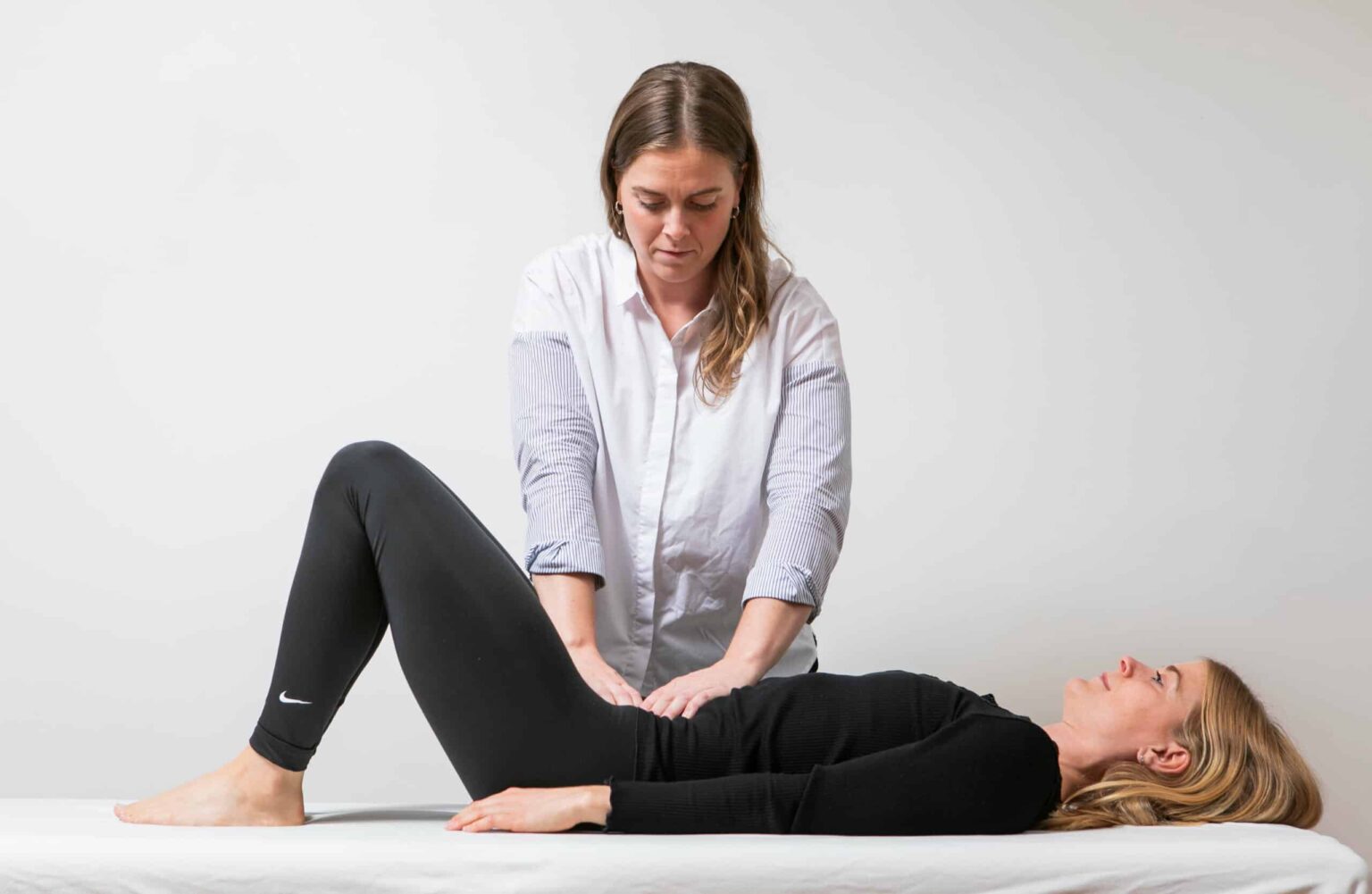
Hysterectomy
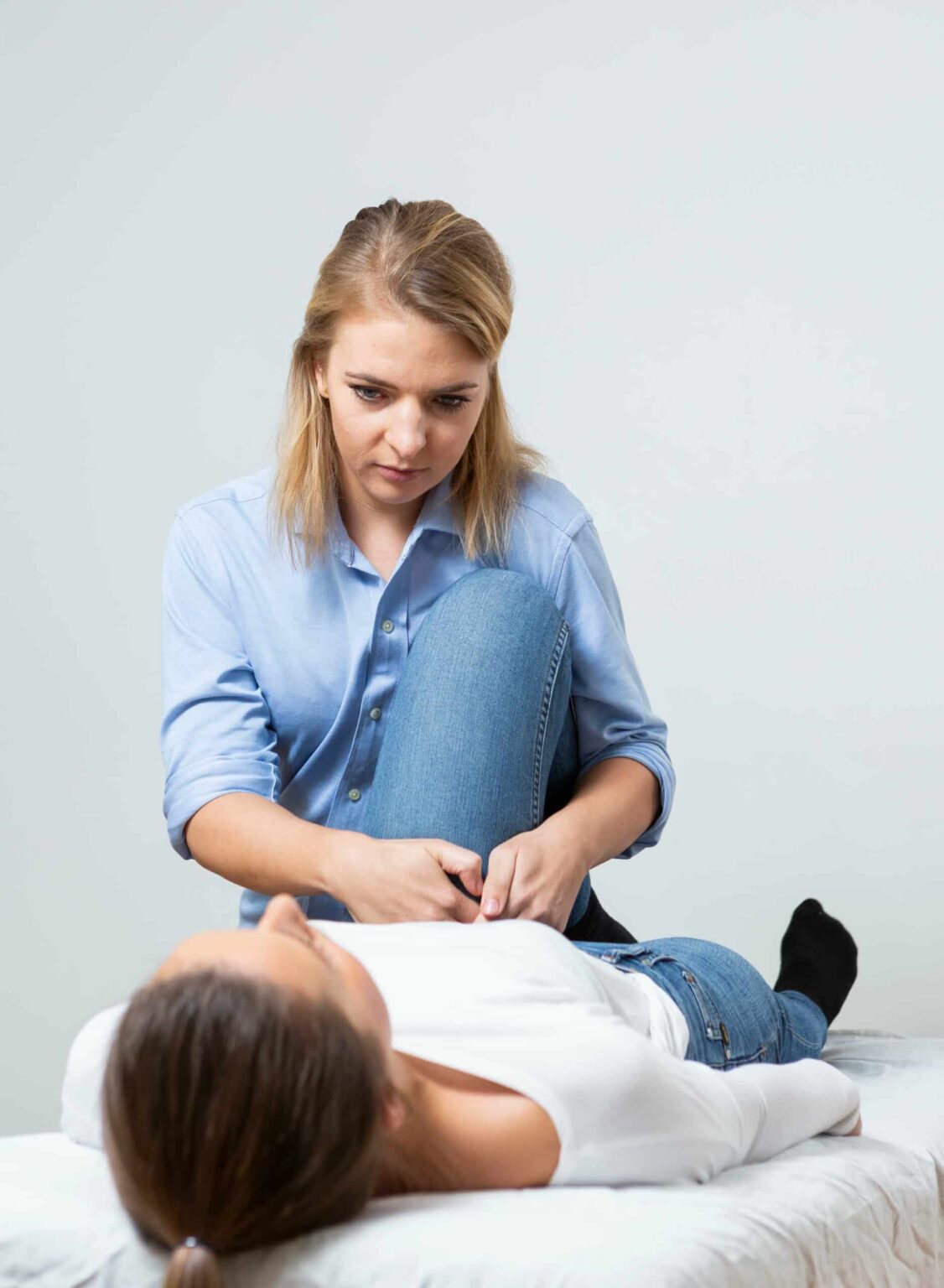
Endometriosis
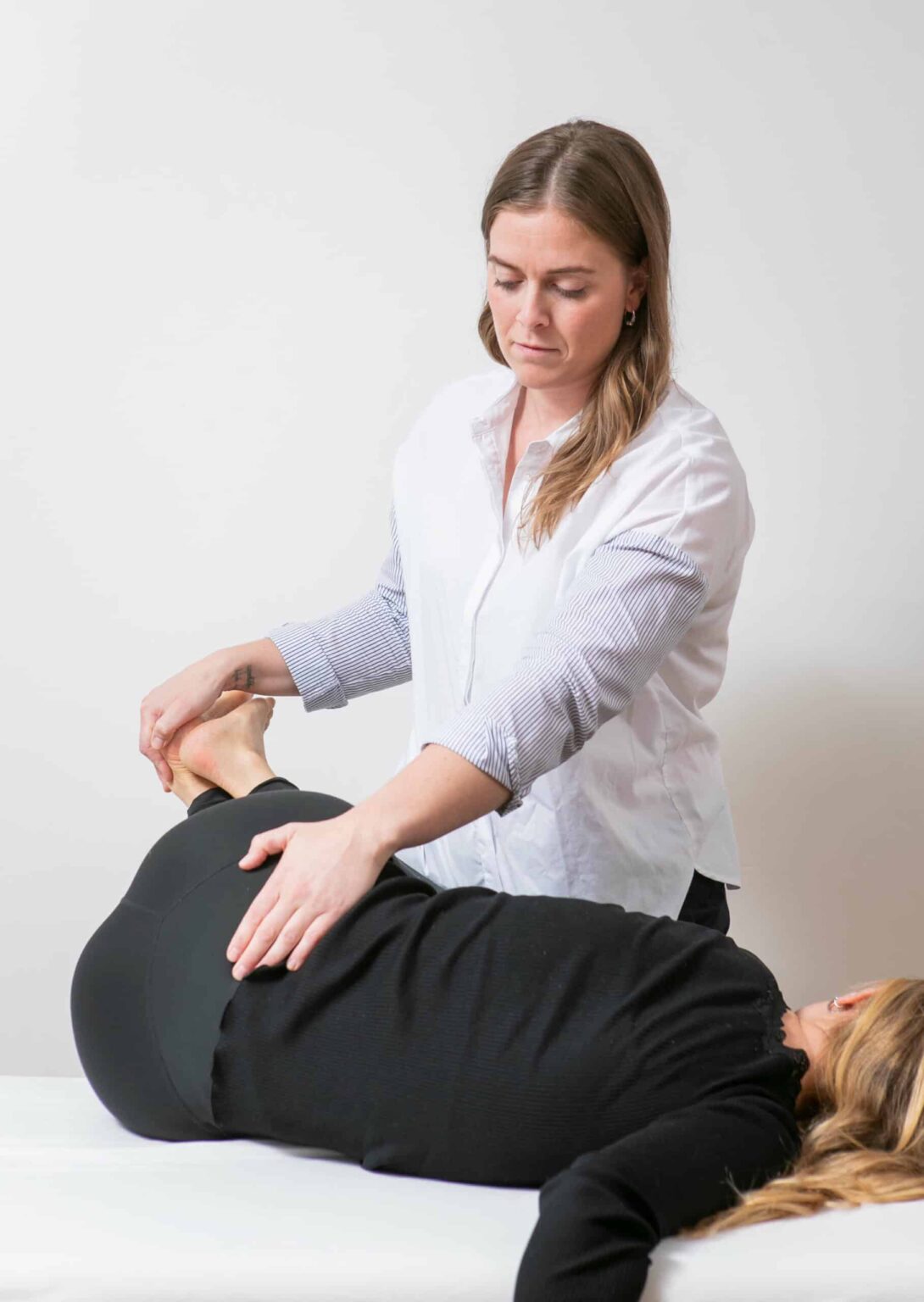
Pelvic pain
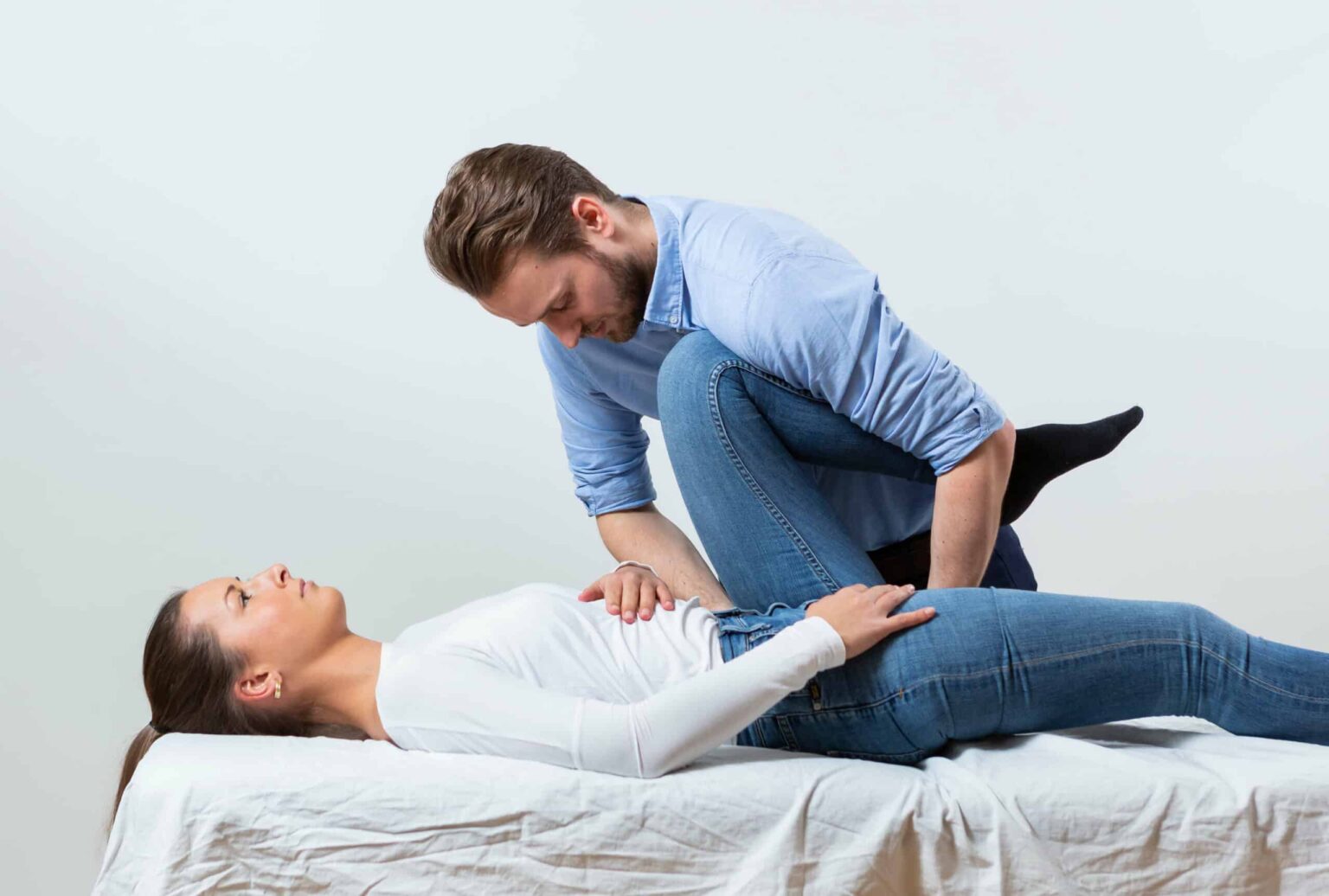
Menstrual pain
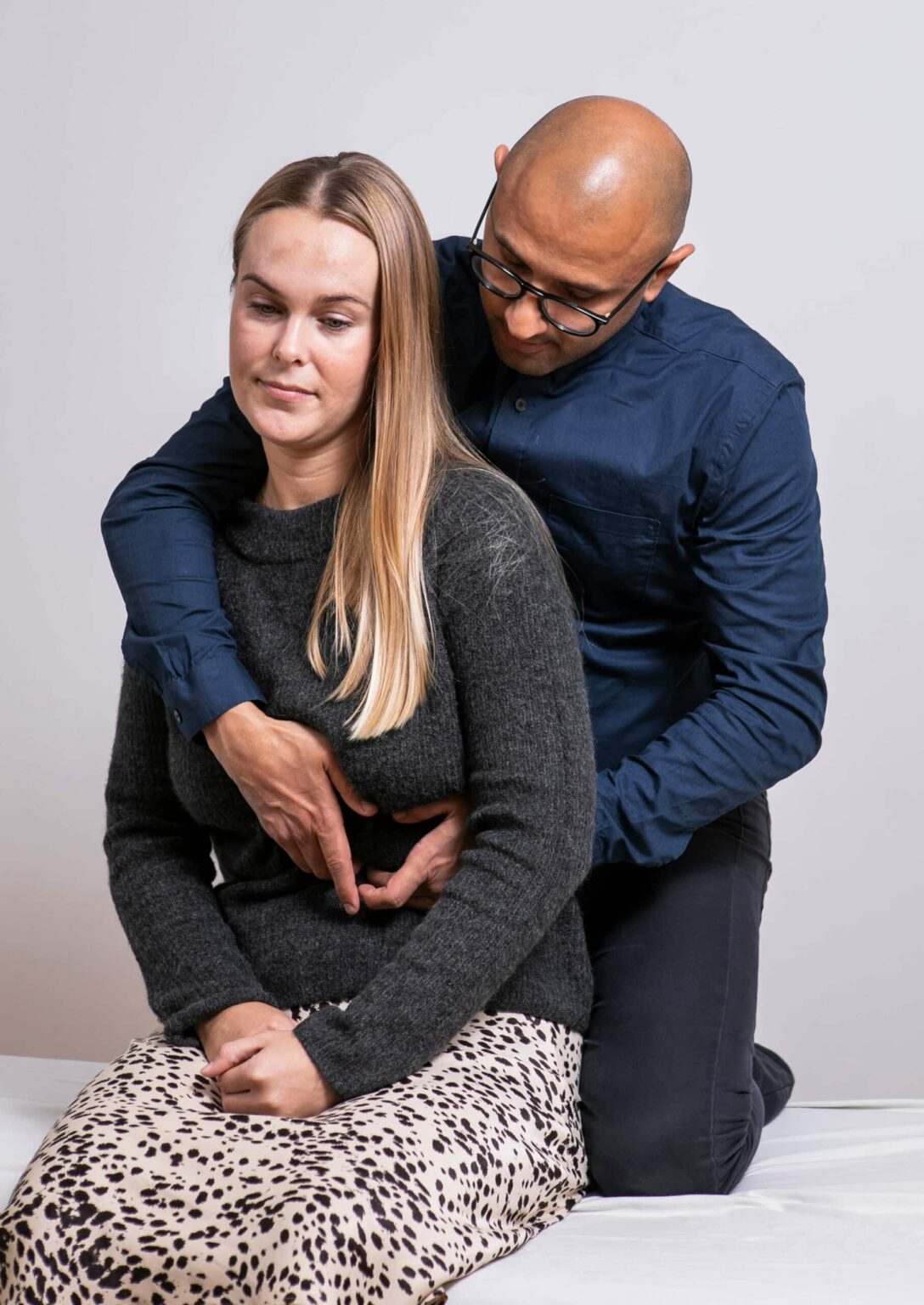
PMS
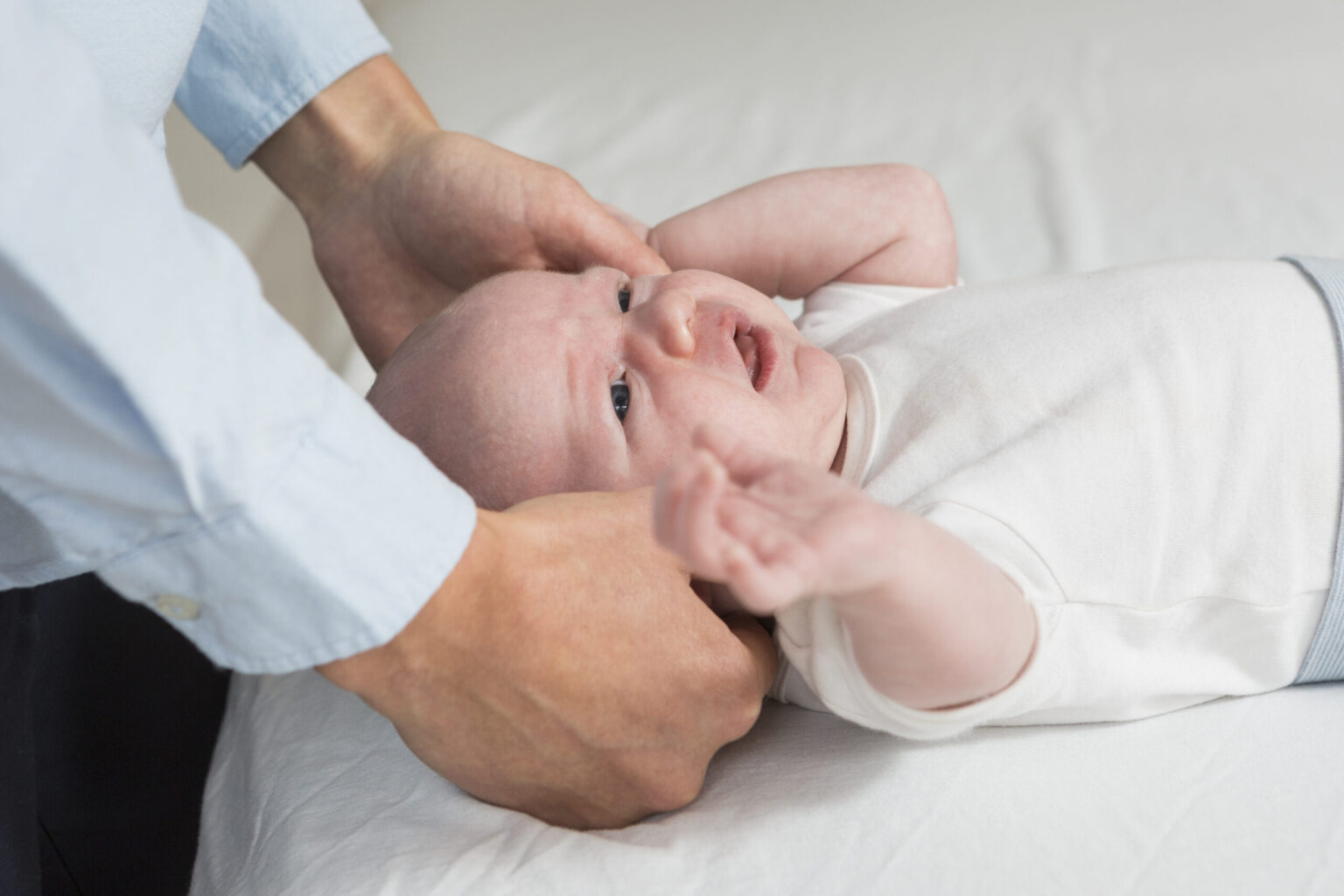
Involuntary infertility
